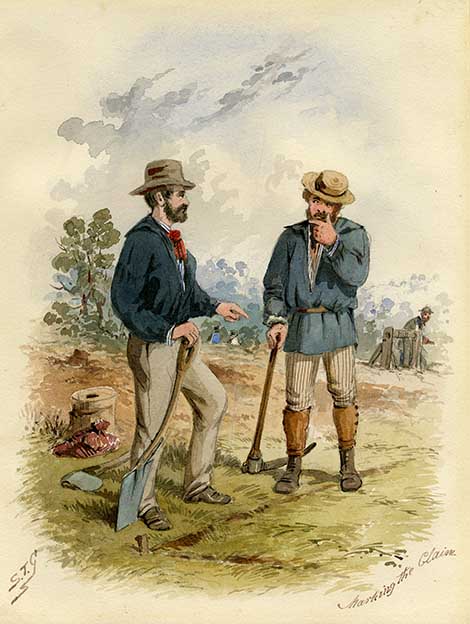Ballarat Mining Board
Contents
History
On 14 March 1858 the Ballarat Mining Board regulations were passed and by June had been duly ratified by Government. The Ballarat Star of 10 March 1858 reported: The first meeting of the members of the newly elected Mining Board took place yesterday, when all the members were present. A Chairman was elected, and diverse important motions passed. It was pretty generally understood that Mr Baker would be elected to the chair, and perhaps he is on the whole, as eligible a member for that office as any one the Board could supply. Upon the good sense, impartiality, and firmness of the chairman, the orderly and decorous conduct of the business of the Board will very much depend; and we will hope the newly-chosen president will follow up his assumption of his duties by discovering all those qualifications which will be required in the future. ...
- ‘The following are the nominations for the Ballarat Mining Board:-Ballarat Division, R. Smith (retiring); Blackwood Division, J. Cann (retiring), W. Byers, T. Maguire; Smythe’s Creek Division, O. R. Stoker (retiring), A. Sutherland; Buninyong Division, J. Magor (retiring), H. Fields. Mr. Smith is elected unopposed, but in the other three divisions contests will take place.’ [1]
Site
Innovations
At the suggestion of Harrie Wood, James Bickett of the Ballarat Mining Board moved the motion to establish Australia's first school of mines at Ballarat in 1869. The Ballarat School of Mines was established in 1870.
The People
James Baker, President (1858>)
F. C. Downes, Chairman
William Frazer (1858>)
Duncan Gillies (1858>)
Joseph Reed (1858>)
T. Richards (<1886>)
Legacies
Newsworthy
- The first Ballarat Mining Board was elected on the 27th February, 1858, and Messrs James Baker, John Yates, Alfred Arthur O'Connor (for Ballarat Proper), William Frazor, Robert Lamb (for Buninyong), Duncan Gillies, Robert Critchley (for Smythesdale), Joseph Reed (for Creswick), — Martin (for Blackwood), and William Butcher (for Slieglitz) were the members, James Baker being chosen chairman. Mr Harrie Wood was appointed clerk, and he has held the office ever since. The first meeting of the board was on the 9th March, 1858. The Local Court members were remunerated by the fees paid in the cases brought before the courts in their judicial capacity. The Mining Boards receive each a Government subsidy of £500 a-year. The courts were more intensely local bodies than are the boards. The boards preside over and legislate for large districts, but the courts had very small areas of jurisdiction, nearly every mining centre, small or large, having its own court and its own regulations.
- In looking at the mixed powers of the Local Courts and their great number, we see the cause of their abolition. The conjunction, of the legislative and judicial functions did not work satisfactorily, and the multiplicity of courts being followed by a multitude of varying regulations, another element of dissatisfaction was found to quicken the desire for further reform. Hence arose the present-Mining Boards and Courts of Mines, the former legislating for districts in which previously, per chance, half a score of Local Courts had exercised their anomalous union of jurisdictions, and the latter exercising judicial functions over areas coterminous with the mining board districts. [2]
See also
Further Notes
References
- ↑ The Argus (Melbourne, Vic. : 1848 - 1956), Tuesday 13 February 1894, page 6. http://nla.gov.au/nla.news-article8728695
- ↑ Ballarat Star, 18 January 1870.
--Clare K. Gervasoni (talk) 01:32, 5 July 2015 (AEST)--C.K.Gervasoni 16:35, 12 March 2011 (EST)
